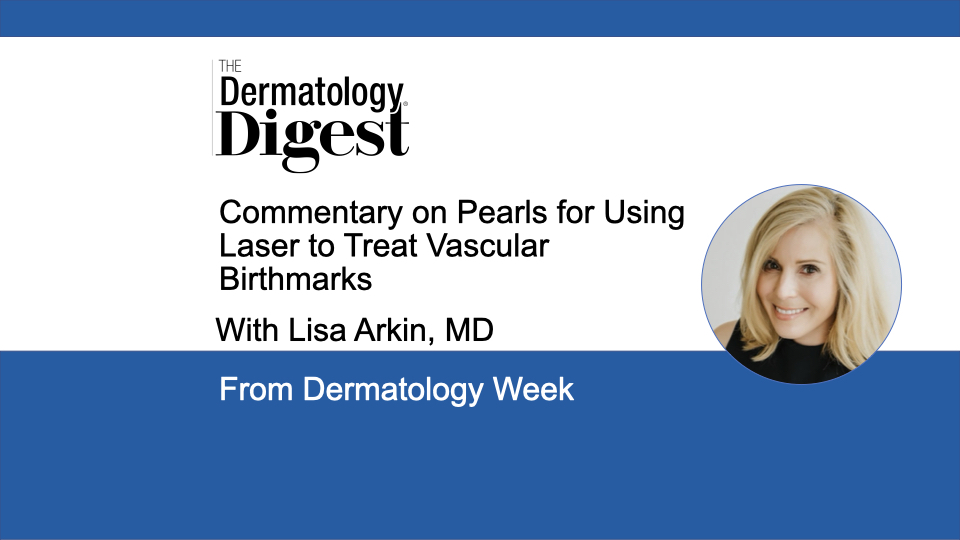Dr. Lisa Arkin discusses optimal timing and laser settings for vascular birthmark treatment.
Lisa Arkin, MD, is Associate Professor and Director of Pediatric Dermatology, School of Medicine and Public Health, University of Wisconsin-Madison
“Capillary malformations, which are also called port-wine stains, affect up to about a half percent of newborns every year. They’re predominantly composed of very tiny blood vessels in the skin, but over time, those become more dilated, the birthmarks darken and can develop overgrowth of the tissue and bleeding, vascular blebs,” said Lisa Arkin, MD, who presented “Pearls for Using Laser to Treat Vascular Birthmarks” at this year’s Dermatology Week conference.
“And studies have shown that without treatment, by your 50s and 60s, about two-thirds of patients will have thickening of the skin, darkening of the skin, and sometimes these hemorrhagic nodules in the skin.”
The current standard of care for treating vascular birthmarks is laser, said Dr. Arkin.
“Laser becomes a very precise form of surgery. Because when you treat the birthmark, you treat just the aberrant blood vessels. The light is targetable just to the blood in the skin, and so it ablates that blood vessel without damaging the surrounding skin.”
According to Dr. Arkin, most port-wine stains are caused by genetic mosaic skin disorders.
“We know that the genetic changes are harbored within the blood vessel. And so the way we think of using laser for these patients is actually that we’re ablating not just the blood vessel, but also the mutation that causes the problem.”
Over the past decade, the specialty has also gained a better understanding of optimal timing and laser settings for vascular birthmark treatment, said Dr. Arkin
“One of the first things that’s been shown pretty definitively is that the earlier you start (in early infancy), the better the outcome.”
It’s during infancy that the skin is thinnest and the blood vessels are smallest, making it ideal for the most effective laser treatment, said Dr. Arkin.
“…we get probably our best results when we start these treatments in little babies and that brings up a lot of concern for parents.”
According to Dr Arkin, the treatment plan becomes a journey between the physician and the family.
“There are a lot of benefits to starting early, including that you don’t need general anesthesia, but you’re balancing how the child is feeling [with] all the things we do to give them comfort because it is a little bit uncomfortable.”
According to Dr. Arkin, she walks parents through the treatment details (even lasers the parents themselves) so they clearly understand the process and value of proceeding at this young age.
“…that’s the time when we get the most improvement in the skin, and those are the areas that tend to have the most sustained clearance. And then it gets a little harder after a year. Sometimes the birthmark just gets smaller, so you need less light delivered to the area. Sometimes it’s pretty small to begin with. But in really extensive cases, then we start to have a discussion around how frequently we need treatment and that’s pretty different for every kid depending on how that first privileged year of improving the birthmark goes.”
3 Pearls for Laser Settings
Effective treatment of vascular birthmarks relies on choosing the right laser parameters, said Dr. Arkin.
First, “Make sure that your chosen wavelength… is targeted for what you’re treating.”
Yes, you’re targeting blood in vascular birthmarks, said Dr. Arkin, but there are variations in affinity for oxygenated (red/purple) vs. deoxygenated blood (blue/purple).
“The second pearl is that pulse duration…is the most critical choice you make in terms of confining your energy.”
The goal is to choose the setting that will most effectively treat the blood vessels while keeping the skin safe and that is determined by the size of the targeted blood vessels, said Dr. Arkin.
“But across different vascular birthmarks, the size of the blood vessels can differ significantly.”
For example, infants have smaller blood vessels than those of adolescents; the vessels in a glomuvenous malformation are even bigger and those in a venous malformation are enormous, she said.
“And so really thinking about the anatomy of vascular birthmark is very helpful in terms of thinking through what the most optimal parameters will be.”
Third, during treatment dermatologists need to keep an eye on therapeutic end targets and warning endpoints, said Dr. Arkin.
“That’s what gives you an idea of whether the treatment is working or whether there are untoward side effects in the skin, where you really want to alter your parameters so that you’re not causing too much damage.”
Disclosure: Dr. Arkin previously received equipment from Candela for a clinical trial. She has received grant funding for investigation of laser in the treatment of port wine birthmarks from the Sturge Weber Foundation, the Pediatric Dermatology Research Alliance, and the Dermatology Foundation.


